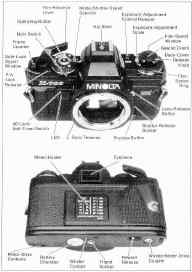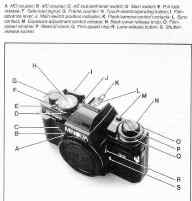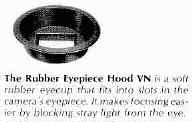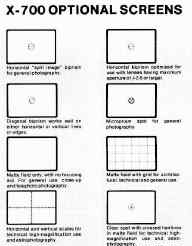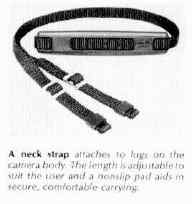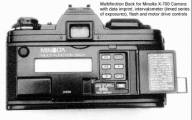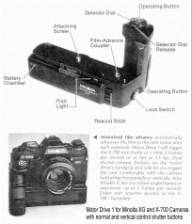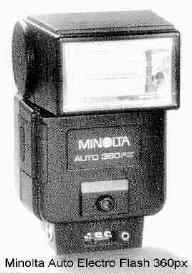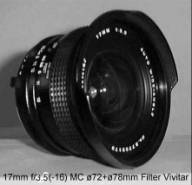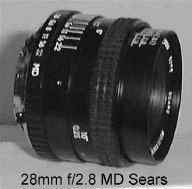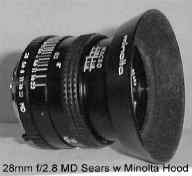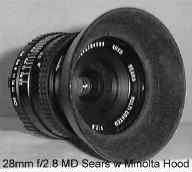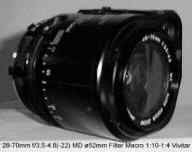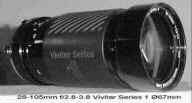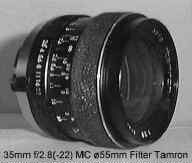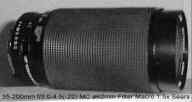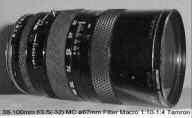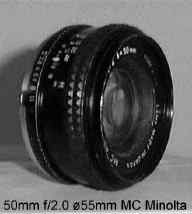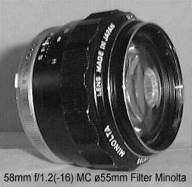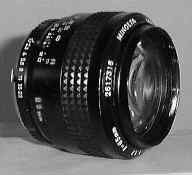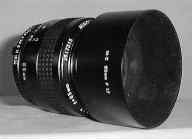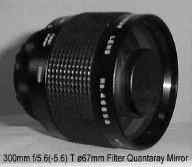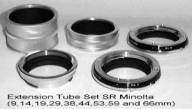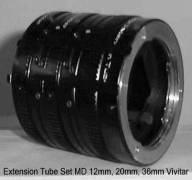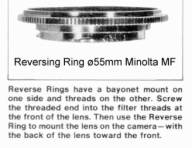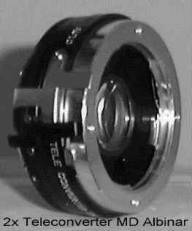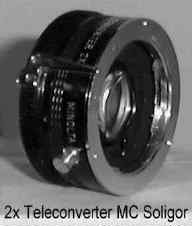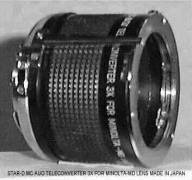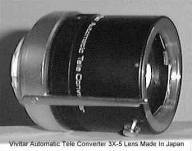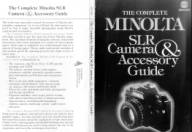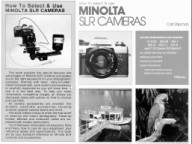 Here are my own Minolta Manual Focus Used (daily!) X-700 Camera Systems,
Lenses, Flash, Motor Drive, Remote Cord, Teleconverters, Extension Tubes,
Lens Reversing Rings and Manuals. These are NOT, repeat NOT for sale at
this time. Most item have caps, UV filter, case, original owner's manuals
and/or other accessories, some accessories are original, all items are
in good working condition - 27 or more items listed here, including products
from:
Here are my own Minolta Manual Focus Used (daily!) X-700 Camera Systems,
Lenses, Flash, Motor Drive, Remote Cord, Teleconverters, Extension Tubes,
Lens Reversing Rings and Manuals. These are NOT, repeat NOT for sale at
this time. Most item have caps, UV filter, case, original owner's manuals
and/or other accessories, some accessories are original, all items are
in good working condition - 27 or more items listed here, including products
from:It's easy to browse: Review items in list ^ and in detail below. See discussion below for Minolta SR/MC/MD/X-600 lens mount compatibility and interchangeability fit and function exploration and explanation! |
... private, individual (I am not a camera store), so, the best way to contact me is via email: [email protected] Peter Blaise Monahon 3686 King Street #185 Alexandria, Virginia (VA) 22302 US Phone 703-845-1556 - Fax 703-845-1894 (My business Web Pages: http://www.peterblaise.com or http://www.geocities.com/peterblaise) |
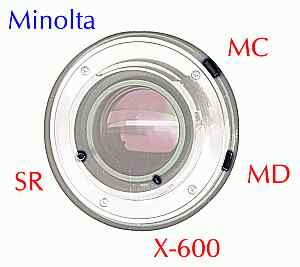 Notes
on Minolta-Style 35mm Manual Focus SLR and T, SR, MC, MD, and X-600
Lens Interchangeability: Notes
on Minolta-Style 35mm Manual Focus SLR and T, SR, MC, MD, and X-600
Lens Interchangeability:(in the process of being edited and further researched - please email me at [email protected] with your comments) Q: "What lenses fit my Minolta Manual Focus 35mm Single Lens Reflex Camera?" A: Virtually all Minolta Manual Focus-style Lenses fit and operate on virtually all Minolta Manual Focus-style 35mm Single Lens Reflex Cameras. (There are three rare exceptions, see below *.) Surprised? Don't be. Minolta, like many manufacturers, (a) designed their cameras 'right' from the start, and (b) didn't want to alienate any of their customers, so they made all their Minolta Manual Focus 35mm Single Lens Reflex cameras with the same bayonet lens mount. So virtually all Minolta Manual Focus-style lenses fit virtually all Minolta Manual Focus-style cameras (35mm SLR Single Lens Reflex, that is)!
Q: What's the difference between Minolta Manual Focus-style T, SR, MC,
MD and X-600 lenses, then?
A: The difference between T, SR, MC, MD and X-600-style lenses is how automatically they coordinate with each different Minolta Manual Focus-style camera's automatic features and controls. You can operate any lens on any camera in fully manual mode. You focus with or without focus confirmation. You set the aperture with or without match-needle exposure confirmation. You open the aperture for a bright, clear viewfinder image during focusing and composition. You close the aperture to the appropriate setting during exposure. All Minolta Manual Focus Cameras with Auto Exposure features designed for MD-style lenses will still use those Auto Exposure features with all Minolta Manual Focus-style T, SR, MC, MD and X-600-style lenses.
T Lens = "T" adapter, a Tamron screw thread lens mounted on a Tamron
screw thread receiver which is mounted in a Minolta bayonet adapter.
No other coupling exists to operate the lens's aperture (if any).
You must manually set the aperture of the lens (if any). Minolta
Auto Exposure Cameras will try to compensate by adjusting the camera's
shutter timing during exposure. Or, you can use the metered manual,
meter assist/match needle mode of your camera.
|
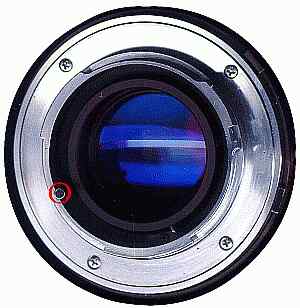 SR
Lens = Original Minolta Manual Focus lenses for Minolta SR-series
cameras starting from the Minolta SR2 in the late 1950s.
They have no meter coupling (MC) feature. Like the T
Lenses above, you must set the lens's aperture manually before exposure.
That is, a fully open lens aperture gives you a bright, clear viewfinder
image, during focusing and composition. Then you close down the
lens aperture to the appropriate f/stop during exposure. Then
you open wide the lens aperture again for the next picture. Some
Minolta SR-series cameras would reset the lens to fully open
aperture after exposure, and this was the first Minolta lens use of
the term 'automatic' regarding lens operation. So, SR lenses
may have a fully automatic diaphragm, semi automatic diaphragm, or function
only in stop down mode. SR
Lens = Original Minolta Manual Focus lenses for Minolta SR-series
cameras starting from the Minolta SR2 in the late 1950s.
They have no meter coupling (MC) feature. Like the T
Lenses above, you must set the lens's aperture manually before exposure.
That is, a fully open lens aperture gives you a bright, clear viewfinder
image, during focusing and composition. Then you close down the
lens aperture to the appropriate f/stop during exposure. Then
you open wide the lens aperture again for the next picture. Some
Minolta SR-series cameras would reset the lens to fully open
aperture after exposure, and this was the first Minolta lens use of
the term 'automatic' regarding lens operation. So, SR lenses
may have a fully automatic diaphragm, semi automatic diaphragm, or function
only in stop down mode.Note: there are perhaps 2 or 3 types of SR lenses - one with NO pin for automatic diaphragm reopening after exposure, one with a long pin for automatic diaphragm reopening after exposure, and the final version with a short pin for automatic diaphragm reopening after exposure. The lenses with the longer pin may physically interfere with the interior of cameras other than the original SR2 for which they were designed, so carefully check the pin length of any SR lens on non SR2 camera. Note also that some older SR lenses are not retrofocus designs and therefore penetrate deeply into the camera body requiring that the reflex mirror be "locked up" - MLU = Mirror Lock Up. So, lenses like the Minolta Auto Rokkor 21mm f/3.5 and f/4 fit only cameras with MLU. There might be other examples - please let me know! By the way, non 'retrofocus' means, for example, that a 21mm lens is actually 21mm from the film which is deep within the ~44mm deep camera body, versus the later design retrofocus lenses that still take in an equivalent angle of view as a 21mm lens, for example, but keep the lens mechanicals outside the camera body, away from the reflex mirror. ... for ALL Minolta 35mm Manual Focus SLR Cameras from 1958 on: generally known as the Minolta SR-series cameras - 1958 Minolta SR-2, SR-1, 1960 Minolta SR-3, 1962 Minolta SR-7, 1965 new SR-1, SR-7, 1967 Minolta SR-1s, 1970 Minolta SR-M, PLUS cameras listed below for subsequent lens mount/tab enhancements. |
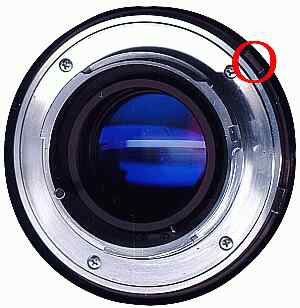 MC
Lens = Meter Coupled lenses introduced with the SR-T-series
cameras starting from the mid-1960s. These lenses couple to a
tab on the camera body and tell the camera what relative aperture you
have set on the lens. The lens stays at wide open maximum aperture
for a bright, clear image in the viewfinder during your focusing and
composition. The camera then closes the lens aperture to the setting
indicated by the lens aperture control ring (as set by you via exposure
match needle) during exposure. The camera then returns the lens
to the maximum aperture after exposure. MC
Lens = Meter Coupled lenses introduced with the SR-T-series
cameras starting from the mid-1960s. These lenses couple to a
tab on the camera body and tell the camera what relative aperture you
have set on the lens. The lens stays at wide open maximum aperture
for a bright, clear image in the viewfinder during your focusing and
composition. The camera then closes the lens aperture to the setting
indicated by the lens aperture control ring (as set by you via exposure
match needle) during exposure. The camera then returns the lens
to the maximum aperture after exposure.Technical Note: The MC lug is needed for a correct meter reading while the lens remains 'open' to provide a bright viewfinder during your pre-exposure focusing and framing. That's why it was introduced in the SR-T cameras. Of course, The MC tab function has nothing to do with the "automatic diaphragm" that was already introduced in the SR Auto Rokkor lenses above. However, this web page is targeted at helping the reader understand how each lens will behave in it's entirety on each camera, hence the discussion of features and benefits other than strict lens to camera fit. ... for ALL Minolta 35mm Manual Focus SLR Cameras from 1958 on (as abbove) PLUS from 1966 on: generally known as the Minolta SR T-series cameras - 1966 Minolta SR T 101 (and subsequent Minolta SR T 100/100b/100x/200/201/202/303/303b/505/MCII and equivanet series cameras), 1973 Minolta SR T SUPER; and even some models without the "T": 1975 Minolta SR 101, Minolta SR 505; Minolta SR 777, PLUS early X-cameras: 1972 Minolta XK/XM/X1, 1973 Minolta X-1, 1974 Minolta XE, 1975 Minolta XE-7/XE-1/XE, 1976 Minolta XK-M/XM Motor/X1 Motor, XE-5/XEb, PLUS cameras listed below for subsequent lens mount/tab enhancements. |
 MD
Lens = Minolta Dual (for the Dual Mode - Aperture
Priority/Shutter Priority - Minolta XD-11 camera on which this pin was
first used) or Minimum Diameter or Minimum Diaphragm
(or something memorable like that) introduced in the mid-1970s with
the Minolta XD-series cameras. The 'MD' tab tells
the camera (1) when the lens is set to allow auto closing down to the
minimum aperture, and (2) what is the minimum aperture (diameter) of
the lens diaphragm - either f/16, f/22 or f/32. When using any
lens that is set to NOT operate the MD tab on a Minolta Auto
Exposure Camera, in Auto Exposure mode the camera will 'guess' and compensate
for the ultimate stopped down aperture during actual exposure.
This even applies to MD lenses where you have not set the aperture
to minimum (oops)! Your Minolta Auto Exposure Camera will try
to take the most accurate exposure given the balance between available
apertures and shutter speeds possible - using whatever lens aperture
setting it finds during actual exposure - and this is why ANY lens that
fits ... works!. MD
Lens = Minolta Dual (for the Dual Mode - Aperture
Priority/Shutter Priority - Minolta XD-11 camera on which this pin was
first used) or Minimum Diameter or Minimum Diaphragm
(or something memorable like that) introduced in the mid-1970s with
the Minolta XD-series cameras. The 'MD' tab tells
the camera (1) when the lens is set to allow auto closing down to the
minimum aperture, and (2) what is the minimum aperture (diameter) of
the lens diaphragm - either f/16, f/22 or f/32. When using any
lens that is set to NOT operate the MD tab on a Minolta Auto
Exposure Camera, in Auto Exposure mode the camera will 'guess' and compensate
for the ultimate stopped down aperture during actual exposure.
This even applies to MD lenses where you have not set the aperture
to minimum (oops)! Your Minolta Auto Exposure Camera will try
to take the most accurate exposure given the balance between available
apertures and shutter speeds possible - using whatever lens aperture
setting it finds during actual exposure - and this is why ANY lens that
fits ... works!.Note: The MD tab may contact the body of the Minolta SR-7 model V prohibiting easy use of the lens's entire aperture range. You can either 'machine' or file the camera body, or file down the lens MD tab, or just not use the entire aperture range of the lens. So, check for MD tab-to-camera body interference. Note also that using an MC lens on a XD camera in S Shutter Priority Mode, for example, means that meter read out can be 'wrong'. However, the camera will still achieve a 'correct' exposure upon shutter release. ... for ALL Minolta 35mm Manual Focus SLR Cameras from 1958 on (as abbove) PLUS from 1966 on (as above) PLUS from 1977 on: generall known as the Minolta X-series cameras - 1977 Minolta XD/XD-7/XD-11, XG-E/XG-2, 1978 XD-s, 1979 Minolta XG-S/XG-1/XG-7/XG-9, Minolta XD-5, 1980 Minolta X-7. 1981 Minolta X-700, 1982 Minolta X-70/XG-M, 1983 Minolta X-500/X-570, 1984 Minolta X-370/X-370, 1997 Minolta X-300s/X-370n, 2000 Minolta X-370s; Minolta XG-A, Minolta XG-SE, Minolta X7A, Minolta X-9, PLUS cameras listed below for subsequent lens mount/tab enhancements. |
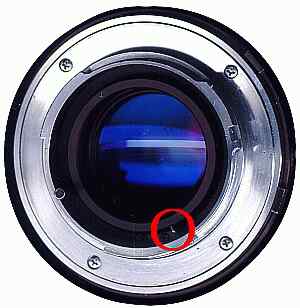 X-600
= On the early 1980s Minolta X-600 camera, intended for Japanese-only
distribution, there is a focus assist and confirmation feature.
The Minolta X-600 sensors need a clue from the lens as to the
lens's maximum aperture so that the camera body can use it's appropriate
range of light sensitivities from which to asses subject contrast for
judging focus accuracy. There is a tang inside the lens that identifies
either (1) f/2.8 or larger maximum lens aperture, or (2) f/3.5 or smaller
maximum aperture. The lens tang operates a switch inside the body
of the X-600. There is no MD Auto Exposure feature on
the X-600. X-600
= On the early 1980s Minolta X-600 camera, intended for Japanese-only
distribution, there is a focus assist and confirmation feature.
The Minolta X-600 sensors need a clue from the lens as to the
lens's maximum aperture so that the camera body can use it's appropriate
range of light sensitivities from which to asses subject contrast for
judging focus accuracy. There is a tang inside the lens that identifies
either (1) f/2.8 or larger maximum lens aperture, or (2) f/3.5 or smaller
maximum aperture. The lens tang operates a switch inside the body
of the X-600. There is no MD Auto Exposure feature on
the X-600.... for ALL Minolta 35mm Manual Focus SLR Cameras from 1958 on (as abbove) PLUS from 1966 on (as above) PLUS from 1973 on (as above) PLUS 1983 on: 1983 Minolta X-600. |
|
Q: Uh-Huh. Hmm ... so, simply please, if there's no difference between
Minolta Manual Focus-style Lenses, then ... what is the difference between
Minolta Manual Focus-style lenses?
A: Simply whether the lens will help the camera in auto mode, or whether the camera will have to 'guess' - which it will do very, very well (hence the Minolta reputation for taking great pictures). You decide which control mode you prefer: Manual Mode - you set Lens Aperture and Shutter Speed to match exposure calculated elsewhere, such as via a hand held meter;Not all Minolta Manual Focus-style lenses will assist all Minolta Manual Focus-style Auto Exposure Cameras to take full advantage of all the lens's or all the camera's automatic features. However, the lens and the camera will still work in the camera's Automatic mode and in the camera's Manual mode. For example, when using a T or SR or MC lens on an MD-style camera, you can still use the camera's Auto Exposure setting (Auto Program, Auto Aperture or Auto Shutter Speed), and the camera will 'guess' what is the lens's aperture before you fully press the shutter button, and the camera will recalculate the actual exposure after you press the shutter button. The camera must guess since there is no MD tab on the lens telling the camera what is the minimum aperture (f/stop) of the lens. On Minolta Auto Exposure Cameras, using a lens with the MD tab will allow the Auto Exposure system to 'know' the minimum aperture (Minimum Diameter or f/stop) of the lens. This 'automatic' coupling feature between the camera and the lens applies mostly to the Minolta XD-7/11 (same camera, different world markets), the XD-5, and the X-700. Personally, I have left my X-700 cameras in Program mode and I have never been let down. The camera sets an appropriate Lens Aperture and Shutter Speed regardless of whether I am using a T, SR, MC or MD lens, and regardless of whether I have remembered to set the lens to it's minimum aperture. Occasionally I set the + or - exposure compensation dial if I know there is an imbalance between bright and dark in the subject, or if I am using a particularly 'dark' (slow) lens. For instance, the 17mm f/3.5 Vivitar MC lens collects so much light that the camera thinks the image is too bright and tries to darken it, so I often dial in +1 or +2 compensation to brighten up an image with 1/2 sky, 1/2 land. ^ |
|
Exception
summary: So, after reading the fine print above, the ONLY exceptions
are (1) some rare early model SR lenses have too long an aperture operating
pin for safe use on cameras other than the equally rare early SR2 camera,
(2) some SR wide angle lenses penetrate so deeply into the camera body
that they require a camera with MLU Mirror Lock Up, and (3) MD lenses
hit an escutcheon screw on the older and rare SR7 model V. That's
it! Virtually all other Minolta Manual Focus-style Lenses fit
and operate on virtually all Minolta Manual Focus-style 35mm Single
Lens Reflex Cameras. Now you can shop and purchase with confidence
regarding what fits what. Return to top
of this interchangeability discussion.
|
Does the following table simplify things?
|
|
|
|
|
|
||||
|
|
|
|
|
|
|
|||
|
|
Camera Shutter: Manual Camera Metering: Manual, not TTL Through The Lens |
Lens
Aperture: Manual Camera Shutter: Manual Camera Metering: Manual, not TTL Through The Lens |
NOTE: Lens MD tab may hit screw on SR Camera body preventing use of minimum Lens aperture Camera Shutter: Manual Camera Metering: Manual, not TTL Through The Lens |
|||||
|
|
MC Camera |
Camera Shutter: Manual, Automatic if available on camera, Camera Metering: Stop Down TTL Through The Lens Metering, |
Shutter: Manual, Automatic Shutter selection if available on camera, Metering: TTL Through The Lens metering |
|||||
| MD Camera |
Camera Shutter: Manual, Automatic if available on camera, Camera Metering: TTL Through The Lens metering |
|||||||
| X-600 Camera |
Camera Shutter: Manual and Automatic, Camera Metering: TTL Through The Lens metering |
|||||||
Or, do you prefer this 'simpler' statement:
|
Virtually ALL Minolta Manual Focus-style 35mm Single Lens Reflex Lenses fit and operate on virtually ALL Minolta Manual Focus-style 35mm Single Lens Reflex Cameras. |
|
Minolta
35mm Manual Focus Single Lens Reflex Camera Interchangeable Lens Designation
Nomenclature:
To: [email protected] http://groups.yahoo.com/group/minoltax700club/ Subject: Re: MD vs. MC [Yahoo! Clubs: Minolta X 700 Club] Date: Sun, 08 Oct 2000 From: Peter Blaise Monahon <[email protected]> [edited] Minolta MC [Meter Coupled] and MD [Minimum Diameter or Minolta Dual-mode] are both Minolta 35mm Single Lens Reflex Camera Interchangeable Manual Focus lens styles, both styles work (more or less) on all Minolta Manual Focus 35mm SLR cameras. MC and MD lenses need an adapter to fit a Minolta auto focus camera [and then the lens aperture is manually operated only, and the auto focus camera exposure meter works only in lens stop down taking aperture mode, and the adapter is equivalent to ~1.6x teleconverter, changing the lens focal length and maximum effective lens aperture]. I found references to double-letter Minolta Manual Focus MC lenses from around the year 1958 on, marked ROKKOR-TC, -TD, -QD, -QE, -QF, -PE, -PF, -PG, -HF, -HG, -HH, -SG, -SI, -OK, -NL, and so on. Apparently the first letter of the two letters is an abbreviation of a Greek(?) or Latin(?) word, and indicates the number of lens groups in the lens construction, where:
Apparently there are also some 10 (Deca?), 11 (Undeca?), and 12 (dodEcA?) lens groups in some Minolta Manual Focus zoom lenses, but I haven't seen a reference to any letter code markings for them, yet. Non-existent codes: D Deca? 10 lens groups U Undeca? 11 lens groups E dodEcA? 12 lens groups A dodEcA? 12 lens groups Apparently the second letter, following the order of the Alphabet, indicates the number of lens elements in the lens, where:
Apparently there are also some 13 (M?), 14 (N?), 15 (O?), and 16 (P?) element Minolta Manual Focus zoom lenses, but again, I haven't seen any double-letter codes for them either, yet. Does anyone know of exceptions? Nonexistent codes: M 13 lens elements N 14 lens elements O 15 lens elements P 16 lens elements 'W' was also used to indicate Wide angle lenses from 21mm to 35mm and it usually proceeded the word ROKKOR. 'RF' was used for ReFlex (mirror) lenses, and 'RF' also proceeded the word ROKKOR. Oh, yes, and of course, 'MC' and 'MD' were also two-letter markings on the lens and usually precede the word ROKKOR. Thus, ROKKOR-IC = 3 lens elements in 3 lens groups, NOTE: -IC is a typographical translation error in some Minolta catalogs - see -TC below ROKKOR-TC = 3 lens elements in 3 lens groups, ROKKOR-TD = 4 lens elements in 3 lens groups, ROKKOR-QD = 4 lens elements in 4 lens groups, ROKKOR-QE = 5 lens elements in 4 lens groups, ROKKOR-QF = 6 lens elements in 4 lens groups, ROKKOR-QH = 8 lens elements in 4 lens groups ROKKOR-PE = 5 lens elements in 5 lens groups, ROKKOR-PF = 6 lens elements in 5 lens groups, ROKKOR-PG = 7 lens elements in 5 lens groups, ROKKOR-PH = 8 lens elements in 5 lens groups ROKKOR-PI = 9 lens elements in 5 lens groups ROKKOR-HF = 6 lens elements in 6 lens groups, ROKKOR-HG = 7 lens elements in 6 lens groups, ROKKOR-HH = 8 lens elements in 6 lens groups, ROKKOR-SG = 7 lens elements in 7 lens groups, ROKKOR-SI = 9 lens elements in 7 lens groups, ROKKOR-OK = 11 lens elements in 8 lens groups, ROKKOR-NJ = 10 lens elements in 9 lens groups ROKKOR-NL = 12 lens elements in 9 lens groups. Whew! This nomenclature style all became passé in the mid 1970's with the introduction of the Minolta X camera series, and was pretty much entirely gone by 1977 with Minolta's introduction of MD lenses and the Minolta XD Cameras, the world's first 35mm SLR with multiple auto exposure modes. Initially, these later US market Rokkor lenses were marked ROKKOR-X, some were also marked with the double letter codes, and some were without the double letter codes. Eventually, all later production lenses have been marked "merely" MINOLTA. Who knows when the last "Rokkor" lens left the Minolta assembly line? Why did Minolta choose Greek or Latin abbreviations? I'm guessing ... mathematics written in ancient Greek was translated into Latin and became the mathematics of Western Europe. KaZuO TaShiMa, the founder in the year 1928 of what was to become MiNolTa in the year 1962, wanted to be the best German camera company in Japan, so ... why not imitate even the language of German science, sort of? I'm guessing! What else evolved inside Minolta lenses during the evolution of the nomenclature on the outside of the lens? Lens coating, lens multi-coating, lens design (ray tracing), barrel construction, filter sizes (most notably a dance between 55 mm filter thread and 49 mm filter thread), internal baffling for flare reduction, number of aperture blades, shape of aperture blades, metal or rubber focus and zoom rings, different color paint used in lens label lettering, and so on. What has Minolta to say? Regarding Minolta lens coatings: According to Minolta Japan web site, in the year 1946, the company that was to become Minolta developed the first lens-coating treatment method used in Japan. Did they coat every lens? Who knows? According to a Minolta brochure around the year 1973, "... Minolta, for decreased flare and improved color rendition, pioneered in developing a special technique called "Apochromatic Coating" a decade and a half ago [around the year 1958?]. This exclusive process provides a double coating of fluorides plus other ingredients to yield a very high rate of light transmission as well as superior color rendition. As a result, Rokkor Lenses give rich, true color tones - better than any other lens made today we are sure you'll agree." This implies that at least from about the year 1973 (if not earlier) to about the year 1977 (with the introduction of Minolta MD lenses), some Minolta MC ROKKOR-xx (double-letter marked as above) Lenses were probably multicoated. Finally, there's more than "Minolta-brand MC" and "Minolta-brand MD" out there - there are 2 other Minolta-brand 35mm Manual Focus SLR lens types out there: - SR-style - the Minolta SR-2 through SR-M, from around the year 1958 through the year 1966 (when the SR-T-series came out), and that's a series of lenses even older than MC, with manual stop down for exposure, (oooh, 'SR' is yet another two-letter marking, and it's not even MC!), and: - Celtic - Minolta's 'inexpensive' line, with models from 28mm to 200mm, from f/2.8 to f/5.6 - MC and MD style. ... and all the non-Minolta lenses from Tamron, Sigma, Vivitar, Tokina, Sears, Spiratone, Rexatar, Soligor, Sankyo Kohki, JCPenny, and many, many others, about which you are all on your own to figure out multicoating, browse to other web resources such as Robert Monahan's (no relation) enormous and enormously wonderful web site at http://mefmt.8k.com/third/ (was at http://www.smu.edu/~rmonagha/third/ which is an old reference and is now defunct) for a discussion, including a list that's about 1,600 lenses long! The following styles fit Minolta Manual Focus 35mm SLRs: SR MC MD T(Tamron)-mount-to-Minolta-SR/MC/MD TX and T4/5-mount-to-Minolta-SR/MC/MD Tamron Adaptall-2-mount-to-Minolta-SR/MC/MD (note - these lenses can also directly fit Minolta AF cameras with a Tamron Adaptall 2 mount, thereby avoiding any teleconverter effect, though aperture operation is manual only on an AF camera) Other-Adapter-mount-to-Minolta-SR/MC/MD So, all you Minolta aficionados out there - have at it! Is anyone still afraid of MC/MD differences? The world is full of new and used lenses waiting for you to come out and play! Tell us what you find! mailto:[email protected] |
| Minolta
MF lenses on AF cameras? A frequent inquiry: > does anyone know if there exists an > adaptor to allow MC or MD lenses to be > used on Minolta AF camera bodies? Yes, Minolta made two 2x teleconverter adapters of superlative optical qualities to fit Minolta manual focus lenses onto Minolta AF cameras, one for under 300mm lenses (S) and one for over 300mm lenses (L). Look for these Minolta brand descriptions and part numbers: Minolta 2x M/A CONVERTER-S 2583-107 ... and ... Minolta 2x M/A CONVERTER-L 2584-107 Use http://www.google.com/ to search for sources, ignore the responses that claim to take your order and let you know when it is back in stock - they are search engine spam. The price range is new ~US$350 or so, to used at whatever anyone thinks it's worth - NOT a popular or fast moving item. Like all lens adapters, they may or may not physically fit a particular lens, and like all adapters, they may or may not degrade the image forming qualities of a lens below your own standards. Be prepared to "buy it and try it". Other manufacturer's made ~1.1x to ~1.6x teleconverter adapters of varying optical qualities to fit Minolta manual focus lenses to Minolta auto focus cameras, as you were sent to on eBay to see, and Sigma made one that even auto focuses when used on the Minolta AF series cameras - the 5000/7000/9000 (but NOT on later series Minolta auto focus cameras). http://www.srbfilm.co.uk/ is a reliable place to purchase new adapters on demand to fit your wonderful Minolta manual focus lenses to just about anything, or to fit just about any lens to a Minolta manual focus camera, including reverse adapters and filter rings for reversed Minolta manual focus lenses. Note that when any lens is fitted to another camera, almost all auto features are not implemented, and all lenses become manual focus, manual stop down metering, and often have a different focal length and different maximum aperture due to needing a teleconverter to accommodate the different distances from the lens mount to the film for each camera system. Tamron is the only exception to this with their Adaptall 2 series of lenses which fit all Minolta 35mm SLR cameras, manual and auto focus, with adapters that have NO teleconverter effect, though they do loose their auto aperture operation on auto focus cameras and become manual stop down metering lenses. See http://www.tamron.com/lenses/prod/adaptall.asp for their modern series of Minolta-fit manual focus lenses. If you are planning on one set of lenses to use on different manufacturer's camera bodies, this is the only way to go. However, most people prefer the benefits of fully functional features from their investment in Minolta-fit manual focus lenses, so they eventually settle down on a matching Minolta manual focus camera body for them, especially when they realize that there is usually a teleconverter effect, and the loss of automatic features, when adapting lenses to fit between different camera body styles, and so they just "settle" on an inexpensive Minolta manual focus camera to use with their Minolta manual focus lenses, and do not try to use such lenses elsewhere. Tell me more about what you are after! Click! Love and hugs, Peter Blaise Monahon Minolta Vivitar Tamron Fujifilm Ilford Kodak Adobe Hewlett Packard et cetera Photographer [email protected] http://www.peterblaisephotography.com/ |
